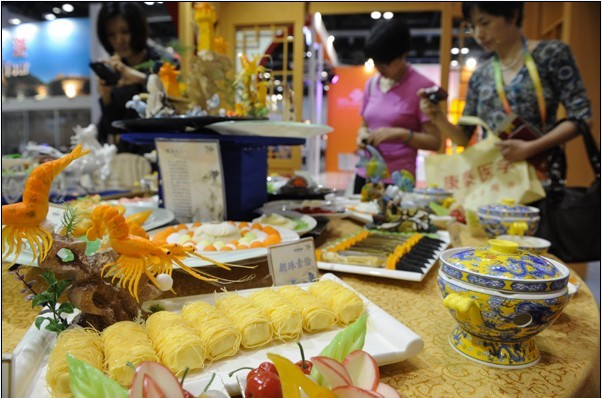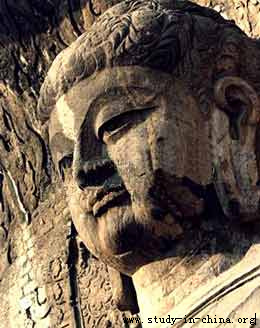| Home > China Feature |
"Double-Seventh Day" Culture in Ancient Pictures
Double-Seventh Day (Qixi), one traditional festival of China, occurs on July 7th of the lunar calendar, which has been conferred as intangible cultural heritage by the State Department since 2007. Legend has it that every year on the night of the Double-Seventh Day, the Weaving Girl and the Cow Herd in heaven meet at the Magpie Bridge. The Weaving Girl is a beautiful and smart fairy with deft hands and the women in the mortal world beg her for intelligence and deft needle work; hence July 7 of the lunar calendar is also called Begging-for-Dexterity Festival (Qiqiao Festival). Also, there are other related activities which will be talked about later.
 |
The Weaving Girl and the Cow Herd on the relief stone sculptures of the Han Dynasty |
As a matter of fact, Altair and Vega are two natural stars in the sky, but people in China have already endowed them with personalities since the Qin Dynasty (221-207BC). As for the Han Dynasty (206BC-AD220), the exquisite description of anthropomorphic features---Weaving Girl and Cow Herd---can be found in the famous 19 poetries. Sima Qian, a famous historian, said in his book Shjii that “Vega is actually the daughter of God.” Then people made up the story of the Weaving Girl and Cow Herd and their reunion finally gave people in love the belief of being together. Similarly, the features of the Weaving Girl and the Cow Herd also appear in historical artistic works. It is said that when the emperor of the Han Dynasty fought with enemies in the south, he constructed a pool in Chang’an to train the marines and there were sculptures of the Weaving Girl and Cow Herd on both sides of the pool.
During the Tang (618-907) and Song Dynasties (960-1279), people paid special attention to love stories. On Jul. 7th, they would arrange some sacrificial offerings to pray for the ideal marriage, and gradually the Double-Seventh Day became a female festival. As for the Northern Song Dynasty (1127-1127), there was a famous street named Pan Lou Street in the prosperous capital of Kaifeng, where early every Double-Seventh Day peddlers would sell various kinds of food and toys, such as exquisite pastries made with oil, sugar, honey and flour; babies made of mud or yellow wax, and so on. Some people even planted grains on slabs and disseminated beans in ceramic containers in order to pray for a bumper harvest. The night market of Kaifeng city on the evening of the Double-Seventh Day is so lively that the famous painter Yan Wengui created a painting named “the nigh market of the Double-Seventh Day.” However, the painting has been lost.
Later, in the Yuan Dynasty (1271-1368) and other dynasties, people and folks would like to put up pictures about the Weaving Girl and Cow Herd and display fruit and wines to celebrate the Double-Seventh Day. Seven close Girls or young women preferred to gather together to prepare all kinds of bright “incense burner tables,” which were made of paper and full of flowers, fruits, rouge powder, small paper clothes, commodities and embroideries, to offer sacrifices to Weaving Girl and Cow Herd from afar. There was even a contest banquet held in the palace to test ingenuity. The contest went like this: when ribbons were scattered down from a streamers-decorated tower, the palace maids would contend to pick them up, and the one who got the most flamboyant ribbon was the winner.
Here are some selected pictures of the Double-Seventh Day:
 |
This picture is named “Banquet Held in the Palace,” or “Begging for Dexterity,” kept in the Metropolitan Museum of Art in America. It’s a copy or revision in the Northern Song Dynasty period describing the senses in the palace in the evening of the Double-Seventh Day adopting the view of overlooking.
 |
This picture describes the musical instruments placed in the palace on the evening of the Double-Seventh Day.
 |
 |
 |
 |
These four pictures above describe the preparation of the banquet held in the evening of the Double-Seventh Day.
 |
This is a painting of begging for dexterity in the palace of Han Dynasty from Li Haohan (Song Dynasty).
 |
This picture was drawn on a fan-shaped pamphlet. It describes the activities in the evening of the Double-Seventh Day of the Han Dynasty. In the picture, the women wearing red, accompanied by the odalisques, walk slowly toward the high building. Odalisques, who are carrying various kinds of sacrificial offerings, look like a needle crossing the high building which is a symbol for begging for dexterity.
 |
This one is a picture created in the Ming Dynasty (1368-1644), symbolizing the Weaving Girl and Cow Herd.
   |
This series of pictures are about the activities of women praying for intelligence and dexterity.
 |
And this one is about the ingenuity test by floating needle. Usually, they put some water in a vessel and leave it in the open air until it is covered by a film of dust, then cast a needle or thin straw on it to see the pattern of the shadow at the bottom. If you see that the feature at the bottom of the vessel is like a cloud, flower, birds or some straight thing, it means the woman is dexterous. Otherwise, she is not.
 |
This picture indicates that women gather together in the yard to beg for dexterity. They place some fruit and food on table in the yard and wait. If there is a cobweb left by a spider, it means that the woman is intelligent.
Art
 more
moreChina Beijing International Diet ...
Recently, The hit CCTV documentary, A Bite of China, shown at 10:40 ...

Exhibition of Ancient Chinese Jad...
At least 8,000 years ago, Chinese ancestors discovered a beautiful...

Longmen Grottoes
The Longmen Grottoes, located near Luoyang, Henan Province, are a tr...

Custom
 more
moreWeb Dictionary
Martial Arts
Tai Chi Master Class Held in Moscow
MOSCOW, June 15, 2016 (Xinhua) -- Students learn from Shaolin ...
Celebriting 70 years' efforts in restoring Mogao...
Work is being carried out at the restoration site of cave No 98 a...
Hong Kong Children's Symphony performs in Seattle
Under the theme of Tribute to the Golden Age, a concert featuring a ...





 print
print  email
email  Favorite
Favorite  Transtlate
Transtlate 








